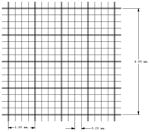Table 1.
The Fuchs-Rosenthal counting chamber can be used for cerebrospinal fluid (CSF) cell counts. This is the normal cell counting chamber that is often used to measure WBC total and differential counts. We adapted this method to quantitatively count yeasts in patients with cryptococcal meningitis.
| 1) PREPARING THE SAMPLE | ||
| The CSF collected in a sterile test tube should contain no visible trace of blood. To place a cover slide in the chamber. After carefully manual homogenization the CSF is filled by capillary attraction into the chamber using a pipette. The CSF will be filled into the chamber without having to be stained first. Care is to be given to make sure that just enough CSF is drawn up with no air bubbles and that the CSF fluid does not spill over the edges of the chamber. After a sedimentation period of approximately one minute, the counting of the yeasts can begin. | ||
| 2) CALCULATING THE YEAST DENSITY |  |
|
| A) SETTING ONE: LOW BURDEN | ||
| Computing the volume | ||
| “A” = total area has 16 large squares sub-divided in 256 small squares | ||
| “AR” = Area of each small square: 0.0625 mm2 | ||
| “P” = Depth of each one of the small square: 0.2 mm | ||
| “VR” = Volume of each small square: | ||
| Calculating formula: | ||
| “VT” = Total volume of the chamber: | ||
| Calculating formula: | ||
| Calculating the number of yeasts (yeasts/mm3) | ||
| Count all the chamber (256 small squares) and divide by “VT” (3.2 mm3) = yeasts/mm3 or mcL | ||
| B) SETTING TWO: HIGH BURDEN | ||
| If there are more than 10 yeasts in each small square, to do a mean (M) in 10 small squares and to multiply by a correction factor (F). The result will be expressed in yeasts/mm3or mL | ||
| Example: M=19, thereby: 19X80=1520 yeasts/mm3or mcL | ||
